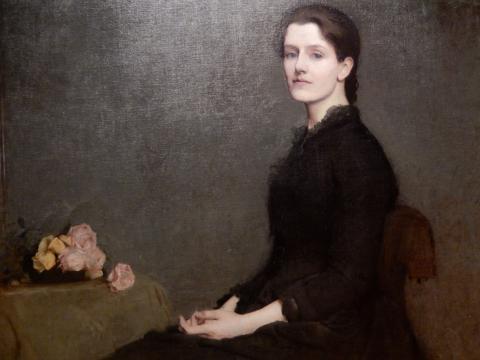Was bleibt? What remains of me when I am dead and gone? This haunting question was especially acute for premodern women unable to control their own textual production, hence afterlife. How then does a lived, biological and historical life become a life, a written artefact; how does that first written text mediate down to us via manuscripts, printed editions, popular translations, strategic revivals, chance discoveries, etc. And how did a premodern woman come or qualify to be remembered by others? So often the answer here appears to be: through egregious misbehaviour. What, not unrelatedly, prompted attempted enclosure of women in convents, houses, and religious houses? What distinctive cultures did such all-female spaces generate? How and why were they mourned, once convents were abolished in Reformation Britain, and how does desire for all-female society live on?
Things were difficult for educated women c. 1150, but they got much worse. The rise of universities, seen as a distinctive sign of progress in western societies, saw increased opportunities for men coupled with, calibrated against, diminished chances for women. No woman after 1150 approached the multi-faceted achievements of Hildegard of Bingen (musician, natural scientist, cosmographer, dramatist, fashion designer, preacher, and author); still in the 1920s Virginia Woolf finds herself being yelled at on the college lawns of Oxbridge before retreating to London, a more sympathetic venue.
These and other issues will be approached through a Smorgasbord of texts, open to the full range of critical approaches and offering a long view of women and writing, c. 1100-1700. Texts will be drawn from four historical phases, beginning with a quartet predating the secure establishment of universities: Hildegard of Bingen (briefly), Christina of Markyate (and associated artwork, made for and depicting her), Marie de France, sublime romancer and fabulist, and Heloise, epistolarienne.
Phase II concentrates upon Margery Kempe and Julian of Norwich, two East Anglian women who actually met, but whose written texts differ greatly. Julian meditates questions of love and death, memory, and the body with an intellectual brilliance second to none in English tradition; only anti-theological prejudice keeps her off the Comp Lit theory list. Margery, au contraire, could not write her own text, but hired a male amanuensis/ scribe/ co-author to compose the first autobiography (some say auto-hagiography) in English. Hope Emily Allen, of Bryn Mawr (where her archive resides), brought Margery into an astonished world in the 1930s; more recent earthquakes include the gay agon of Margery Kempe (1994) by Robert Glück, co-founder of the New Narrative Movement in San Francisco in the early 1980s.
Part III considers whether a woman may write or script her own life in conditions of extreme political pressure and societal disruption, specifically here the English (and European) Reformation-- when women are so often crushed, beheaded, burned, or sacrificed as political pawns: wives of Henry VIII, the nun of Kent, Anne Askew, and Margaret Clitheroe come to mind. Isabella Witney, working woman, provides welcome relief in using printed literacy to advance her own career, although London proves a cruel lover. Mary Sidney lives secludedly at Wilton, in a great house that was once a great convent, reading psalms, like nuns long before her; her psalmic verse marries brilliant poetic experimentalism with Calvinist terror. Elizabeth Carey writes the first closet drama in English by drawing Miriam, Queen of Jewry, from newly-translated Josephus; she then disgraces herself by becoming Catholic and mothering four brilliant daughters (who copy and conserve the text of Julian of Norwich). This they must do abroad, as Catholic nuns; Mary Ward, a Catholic from Yorkshire, joins them in exile, but founds an international order for women who will not be enclosed. Her vast archive, closed to the public for centuries, is now available. Aemilia Bassano, daughter of an Italian court musician, publishes a remarkable collection of verse as Aemilia Lanyer that includes the first English country-house poem. This explores the reverse of enclosure: women happily gathered in female society must soon be scattered, following the iron logic of the marriage market.
Finally we come to the English civil war and the Restoration, and to Margaret Cavendish, Duchess of Newcastle (and Aphra Behn). Two texts that we will visit in Van Pelt tell an eloquent story: the vast, lavishly-funded tome of Cavendish’s plays, and Behn’s meagre play text. Cavendish eagerly keeps up with contemporary science, authors a feminist sci-fi utopia in Blazing World, and strategically exploits the resource of her own beauty. Cavendish continues to ponder the possibilities of all-female society, in both her Convent of Pleasure and, more seriously, her Female Academy. Such longing for female places of learning endures, in various forms, through the nineteenth and twentieth centuries.
These premodern texts may be studied in and of their own time, or as they emerge into print and public consciousness in later centuries; the 1930s, for example, is a remarkable medievalist decade.
One long essay, with opportunities for class reports.

 Department of English
Department of English
